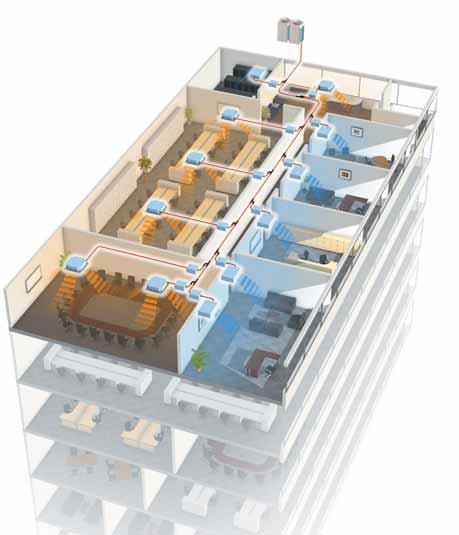The benefits of heat recovery VRF air conditioning systems

With a range of large residential and commercial air conditioning products available in Australia, it can be difficult for consultants and building developers to know which system is the best available to suit their various projects.
Offering simultaneous heating and cooling operation on one piping system, exceptional installation flexibility, energy management benefits and a myriad of control options, heat recovery variable refrigerant flow (VRF) systems from leading manufacturers are now widely available in Australia.
ADVERTISEMENT
There will be growing uptake within the building industry for this type of air conditioning system as there are long term savings to be gained together with its suitability for installation into existing, as well as new commercial and high-end residential projects. With this in mind, air conditioning system designers should be embracing this type of solution, specifying it in all suitable projects.
Decision influencers
Customers in both the residential and commercial sectors are more educated than ever on air conditioning systems and what is available. This helps them select not only the most efficient product to suit their needs, but also a system that is unobtrusive and quiet while in operation.
Customers want user-friendly controls with the ability for high-end interface with home automation and building management systems. This helps to ensure that the overall energy costs for any building installation are reduced.
Energy efficiency remains one of the most important factors for air conditioning installation – regardless of whether the customer is a new home owner or a commercial developer. Increasing electricity costs as well as the introduction of the carbon tax have created an increased demand for energy efficient systems.
With the capacity to heat and cool different parts of a building simultaneously from just one outdoor unit, a heat recovery VRF system has the potential to deliver maximum energy savings. These types of VRF systems can transfer the heat extracted from the spaces requiring cooling to areas demanding heating, resulting in less energy wastage and lower operating costs, meeting this key requirement for users.
Who’s in control?
When specifying a VRF system, one of the key questions to ask a customer is how they want to control the system. This can be influenced by the size of the project. Control options range from individual wired or wireless remote controls for room or area specific temperature control management, through to system controller software programs, which provide optimal energy management and can calculate electricity usage for individual tenants.
Know your stuff
While leading brands can offer high-performance solutions for a project’s air conditioning needs, the installer needs to be aware of the latest products and technologies to ensure they can advise on the best system and design.
From a manufacturer’s perspective it is vital their products are handled by highly experienced professionals. As a result, leading manufacturers always conduct VRF training courses to help contractors keep their knowledge of product development and technologies current. These are also opportunities for electrical contractors to expand their skill set to specify and design air conditioning systems for their customers.
What does the future hold?
Building compliance regulations, such as National Australian Built Environment Rating System (NABERS) and Green Star, mean manufacturers need to ensure new technologies keep their products at the forefront of energy efficiency. There will be a real push for energy management controlling systems in commercial and large residential buildings to ensure overall operating costs are kept at a minimum.
There will also be many manufacturers investigating the use of different refrigerants to help try and increase efficiency and reduce the impact of the equivalent carbon levy which has been in place since 1 July under the Government’s Green Energy plan.
With a more educated market now sourcing air conditioning solutions, the designer needs to be a step ahead – and more aware of the installation efficiencies and the long-term benefits a system can offer a project.
Designers and contractors need to work with the client to arrive at a mutually beneficial outcome. They can be confident of their decision knowing air conditioning systems offered by leading brands in Australia today are globally recognised and specified, and highly efficient solutions.
Peter Cashel is the national product manager for Fujitsu General. He has worked with Fujitsu for 15 years and is currently on advisory and standards committees relating to air conditioning guidelines and compliances.
-
ADVERTISEMENT
-
ADVERTISEMENT

